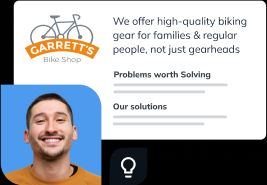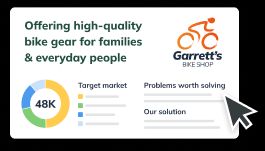Mike's Trucking Service
Problem & Solution
Problem Worth Solving
The USA has grown to be prosperous with many huge cities over miles of land. The cities need food and supplies. Long-haul trucks are the fastest and most efficient way to get people food before it spoils and other supplies that people need.
Our Solution
Mike’s will offer both for-hire trucking as well as private carriers. Most of their business will be derived from the private carriers. For the private carrier segment, both truckload (TL) and less than truckload (LTL) will be offered. Mike’s services will be especially attractive to the food industry, as participants in that industry typically use referrals, reputation, and customer service as purchasing variables.
Target Market
Market Size & Segments
Market Segmentation
There are several potential customer segments that we will provide our transportation services to. Major customer segments include the food industry, PC, and semiconductor manufacturers, and retailers. The chart and table below outline the current market size and growth estimates for these customer segments in Texas.
Large established companies in the afore-mentioned segments (especially in the food industry) have their own truck fleets, while smaller players outsource the transportation function. The latter vary in the scale of their operations but have a steady demand for reliable transportation solutions. We will actively solicit such customers.
Target Market Segment Strategy
Mike’s Trucking will focus its marketing budget on a selected industry niche. A narrow-served market focus will help strengthen the company’s reputation of a reliable transportation services provider and will generate favorable referrals.
The major customer segment the company is focusing on is the food industry. Companies in this segment have varying needs, and Mike’s Trucking has already gained valuable experience serving such customers. The company management believes that by increasing its truck fleet it can capture additional clients and provide better service to existing clients.
Competition
Current Alternatives
Private carriers
Although private carriers comprise the largest component of the motor carrier industry, financial information isn’t available for them. However, the industry is estimated to provide services valued at some $200 billion annually (or 58% of motor carrier revenues in 1998).
The American Trucking Association (ATA) estimates that there are more than three million trucks operated by private fleets transporting 3.5 billion tons of freight annually.
For-hire carriers
The for-hire category generated $144 billion in 1998, or 42% of the industry total. Of that $144 billion, some $105 billion (73% of the sector’s business) came from truckload shipments, and $39 billion (27%) was from less-than-truckload and package/express delivery.
- Truckload (TL). The national for-hire truckload segment had total revenues of $65 billion in 1998. The TL sector has historically been mostly privately owned, with the exception of the top ten publicly-owned companies (For this reason, we focused on the LTL sector in this survey). Schneider National Carriers was the largest TL operator, with revenues of $2.8 billion in 1998, followed by J.B. Hunt Transport Services ($1.8 billion), and the Landstar family of truckload carriers ($1.3 billion). Of the 50,000 truckload carriers, perhaps 95% had annual revenues of less than $1 million.
- Less-than-truckload (LTL). The ATA estimates that the less-than-truckload market garnered $20 billion in 1998. Of this amount, the fast-growing regional segment accounted for slightly more than the national market.
Our Advantages
Our major competitive advantage is the vast industry experience and solid reputation of its owner, Mike Smith. His company is also well known among its clients for going that extra mile in the customer-service department.
Marketing & Sales
Marketing Plan
We market our services as solutions to the many companies requiring cargo to be transported promptly and efficiently. The company’s future marketing plans will be nationwide, emphasizing haulage capabilities for any cargo. The overall marketing plan for services is based on the following fundamentals:
- The segment of the market(s) planned to reach.
- Distribution channels planned to reach market segments: television, radio, sales associates, and mailings.
- The share of the market expected to capture over a fixed period of time.
Sales Plan
At the time of this writing, Mike’s Trucking has a lease arrangement with various companies. The company’s pricing is based on miles per thousands of pounds of cargo transported. We will be able to charge competitive rates, as we have minimal overhead compared to our competition. The table below sketches out the pricing structure; for a key to this table please see asterisks at the bottom of the page.
Operations
Locations & Facilities
Mike’s will offer both for-hire trucking as well as private carriers. Most of their business will be derived from the private carriers. For the private carrier segment, both truckload (TL) and less than truckload (LTL) will be offered. Mike’s services will be especially attractive to the food industry, as participants in that industry typically use referrals, reputation, and customer service as purchasing variables.
Milestones & Metrics
Key Metrics
- Freight cost per unit shipped
- Outbound freight costs
- Inbound freight costs as percentage of purchases
- Transit time
- Claims as % of freight costs
- sales
- loads
- maintenance
- driver commissions
- leads
- closes
- clients
- repeat clients
Overview
Ownership & Structure
Mike’s Trucking has been in business for one year. We have maintained financial stability during the first year of operation due to the extensive industry experience of our management team.
The company’s management is minimal in order to reduce the overhead. Mike Smith, the company owner, and president makes all executive decisions. At the moment, he also generates most of the sales leads. Joan Rose works as an executive secretary who answers phone inquiries and maintains the customer database. A part-time sales representative will be hired to solicit new business once the company acquires new trucks. In year 2 the administrative staff is planned to increase in order to handle the higher sales volume. In the future, a sales manager will be hired to allow Mr. Smith more time to dedicate himself to company management.
Team
Management Team
The management of Mike’s Trucking is highly experienced and qualified. Mike Smith, president and CEO, has been involved in the trucking industry for 15 years. He is well respected by the trucking professionals with whom he has worked. All administrative functions are performed by Joan Rose, who has worked with Mr. Smith for the last seven years. She possesses extraordinary customer service and database management skills.
The company’s management philosophy is based on responsibility and mutual respect. Mike’s Trucking maintains an environment that stimulates productivity and emphasizes respect for customers and fellow employees. The company structure is linear, which leads the staff responsibilities and decision-making power.
Our truckers on salary earn about $50K per year, which is close to the national average. Our two own-operators earn less because we are building a company.
Personnel Table
| 2020 | 2021 | 2022 | |
|---|---|---|---|
| Mike Smith | $43,200 | $44,064 | $44,945 |
| Joan Rose | $36,000 | $36,720 | $37,454 |
| Truckers | $51,408 | $104,872 | |
| Totals | $79,200 | $132,192 | $187,271 |
Forecast
Key Assumptions
Our assumptions:
- Trucks are the best way to get food and supplies
- The market will pay the prices needed to support the trucks
Revenue by Month

Expenses by Month

Net Profit (or Loss) by Year

Financing
Sources of Funds
This business is owner operated and owner funded.
Statements
Projected Profit & Loss
| 2020 | 2021 | 2022 | |
|---|---|---|---|
| Revenue | $204,000 | $298,000 | $486,000 |
| Direct Costs | $81,600 | $119,200 | $194,400 |
| Gross Margin | $122,400 | $178,800 | $291,600 |
| Gross Margin % | 60% | 60% | 60% |
| Operating Expenses | |||
| Salaries & Wages | $79,200 | $132,192 | $187,271 |
| Employee Related Expenses | $15,840 | $26,438 | $37,455 |
| Sales and Marketing | $2,380 | $1,500 | $1,500 |
| Utilities | $2,400 | $2,400 | $2,400 |
| Insurance | $4,800 | $4,800 | $4,800 |
| Total Operating Expenses | $104,620 | $167,330 | $233,426 |
| Operating Income | $17,780 | $11,470 | $58,174 |
| Interest Incurred | $1,949 | $1,183 | $950 |
| Depreciation and Amortization | $3,600 | $3,600 | $3,600 |
| Gain or Loss from Sale of Assets | |||
| Income Taxes | $1,835 | $1,003 | $8,043 |
| Total Expenses | $193,604 | $292,316 | $440,418 |
| Net Profit | $10,396 | $5,684 | $45,582 |
| Net Profit/Sales | 5% | 2% | 9% |
Projected Balance Sheet
| Starting Balances | 2020 | 2021 | 2022 | |
|---|---|---|---|---|
| Cash | $105,000 | $91,370 | $93,711 | $131,140 |
| Accounts Receivable | $10,000 | $26,400 | $29,800 | $48,600 |
| Inventory | ||||
| Other Current Assets | ||||
| Total Current Assets | $115,000 | $117,770 | $123,511 | $179,740 |
| Long-Term Assets | $40,000 | $40,000 | $40,000 | $40,000 |
| Accumulated Depreciation | ($4,000) | ($7,600) | ($11,200) | ($14,800) |
| Total Long-Term Assets | $36,000 | $32,400 | $28,800 | $25,200 |
| Total Assets | $151,000 | $150,170 | $152,311 | $204,940 |
| Accounts Payable | $3,500 | $14,167 | $15,828 | $25,134 |
| Income Taxes Payable | $1,672 | $254 | $2,013 | |
| Sales Taxes Payable | $0 | $0 | $0 | |
| Short-Term Debt | $23,565 | $3,785 | $4,018 | $4,266 |
| Prepaid Revenue | ||||
| Total Current Liabilities | $27,065 | $19,624 | $20,100 | $31,413 |
| Long-Term Debt | $21,435 | $17,650 | $13,632 | $9,366 |
| Long-Term Liabilities | $21,435 | $17,650 | $13,632 | $9,366 |
| Total Liabilities | $48,500 | $37,274 | $33,732 | $40,778 |
| Paid-In Capital | $105,000 | $105,000 | $105,000 | $105,000 |
| Retained Earnings | ($2,500) | ($2,500) | $7,896 | $13,580 |
| Earnings | $10,396 | $5,683 | $45,582 | |
| Total Owner’s Equity | $102,500 | $112,896 | $118,580 | $164,162 |
| Total Liabilities & Equity | $151,000 | $150,170 | $152,311 | $204,940 |
Projected Cash Flow Statement
| 2020 | 2021 | 2022 | |
|---|---|---|---|
| Net Cash Flow from Operations | |||
| Net Profit | $10,396 | $5,684 | $45,582 |
| Depreciation & Amortization | $3,600 | $3,600 | $3,600 |
| Change in Accounts Receivable | ($16,400) | ($3,400) | ($18,800) |
| Change in Inventory | |||
| Change in Accounts Payable | $10,667 | $1,661 | $9,306 |
| Change in Income Tax Payable | $1,672 | ($1,418) | $1,759 |
| Change in Sales Tax Payable | $0 | $0 | $0 |
| Change in Prepaid Revenue | |||
| Net Cash Flow from Operations | $9,935 | $6,126 | $41,447 |
| Investing & Financing | |||
| Assets Purchased or Sold | |||
| Net Cash from Investing | |||
| Investments Received | |||
| Dividends & Distributions | |||
| Change in Short-Term Debt | ($19,780) | $233 | $248 |
| Change in Long-Term Debt | ($3,785) | ($4,018) | ($4,266) |
| Net Cash from Financing | ($23,565) | ($3,785) | ($4,018) |
| Cash at Beginning of Period | $105,000 | $91,370 | $93,711 |
| Net Change in Cash | ($13,630) | $2,341 | $37,429 |
| Cash at End of Period | $91,370 | $93,711 | $131,140 |




